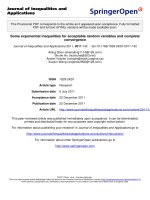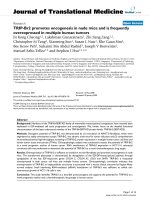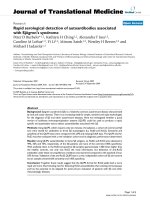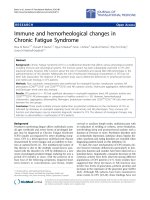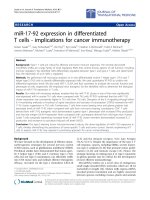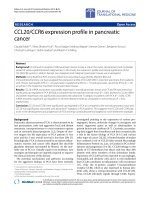báo cáo hóa học:" Common extensor origin release in recalcitrant lateral epicondylitis - role justified?" docx
Bạn đang xem bản rút gọn của tài liệu. Xem và tải ngay bản đầy đủ của tài liệu tại đây (230.03 KB, 3 trang )
RESEA R C H ART I C L E Open Access
Common extensor origin release in recalcitrant
lateral epicondylitis - role justified?
Faizal Rayan
1*
, Vittal SR Rao
2
, Sanjay Purushothamdas
3
, Cibu Mukundan
4
, Syed O Shafqat
5
Abstract
The aim of our study was to analyse the efficacy of operative management in recalcitrant lateral epicondylitis of
elbow. Forty patients included in this study were referred by general practitioners with a diagnosis of tennis elbow
to the orthopaedic department at a district general hospital over a five year period. All had two or more steroid
injections at the tender spot, without permanent relief of pain. All subsequently underwent simple fasciotomy of
the extensor origin. Of forty patients thirty five had improvement in pain and function, two had persistent symp-
toms and three did not perceive any improvement. Twenty five had excellent, ten had well, two had fair and three
had poor outcomes (recurrent problem; pain at rest and night). Two patients underwent revision surgery. Majority
of the patients had improvement in pain and function following operative treatment. In this study, an extensor fas-
ciotomy was demonstrated to be an effective treatment for refractory chronic lateral epicondylitis; however, further
studies are warranted.
Introduction
Lateral epicondylitis is char acterised by localised pain
over the origin of extensor muscles of the finger and
wrist at the lateral epicondyle. The cornerstone of the
diagnosis are detailed history regarding aggravating and
relieving factors and the provocative tests like grasping
in elbow extension, resisted wrist and long finger exten-
sion and resisted forearm supination [1]. There is often
a decrease in the grip st rength [1]. Differential diagnosis
includes radial tunnel syndrome, radio humeral arthritis,
osteochondritis of capitellum, posterolateral instability
of the elbow and injury to lateral ante brachial cuta-
neous nerve [1-3]. An AP, lateral and radiocapitellar
view are used as primary imaging modality in order to
rule out intraarticular disease or a musculoskeletal
tumor. The other imaging techniques like magnetic
resonance imaging, electromyography and nerve con-
duction studies may be complementary [1].
Most of the current non-operative modalities utilized
in the treatment on lateral epicondylitis are not evidence
based [1]. Most of the studies do not differentiate
between clinical and statistical significance, and they
were unable to depict any beneficial effect of their tre at-
ment over natural history of the condition. Patients who
fail to respond to conservative measures may require
surgery (<10%) [2]. Various operative techniques includ-
ing open, percutaneous and arthroscopic techniques
have been described [2]. Percutaneous procedure has an
advantage of reduced morbidity but it has an inherent
possibility of inadequate resection or recurrence [4].
Also it is not possible to rule out intraarticular pathol-
ogy (concurre nce of 18.8%) [5]. In the literature there is
only one study comparing all three techniques, even
though it was done retrospectively [2].
Materials and methods
In a 5 year period 40 patients referred by general practi-
tionersastenniselbowwhohad surgical intervention
were reviewed in this retrospective study. The surg ery
was performed by the senior author. The inclusion
criteria were 1. Clinical diagnosis (tenderness on provo-
cative tests) 2. Patients who had failed conservative
treatment (All patients had two or more cortisone injec-
tions, splints, oral anti-inflammatory agents and activity
modification before the operation.Theyalsoreceived
physiotherapy in the form of heat, ultrasound and
muscle strengthening exercises. All had 2 or more corti-
sone injections at the tender spot with recurrence of
symptoms). The exclusion criteria were 1. Patients with
neck pain 2. Patients with inflammatory arthropathy 3.
History of trauma. All patients included in this study
* Correspondence:
1
Department of Trauma & Orthopaedics, University College Hospital, London
UK
Rayan et al. Journal of Orthopaedic Surgery and Research 2010, 5:31
/>© 2010 Rayan et al; licensee BioMed Central Ltd. This is an Open Access article distributed under the terms of the Creative Commons
Attribution License ( which permits u nrestricted use, distribution, and reproduction in
any medium, provid ed the original wor k is properly cited.
had telephonic questionnaire or follow up examination.
Demographics, medical history, co-existing orthopaedic
problems and surgical findings were gleaned from the
records. Dominant limb was involved in 34 patients
with duration of symptoms for more than 12 months.
All the 40 refractory cases underwent simple fasciotomy
of the extensor origin. Results were rated as per Grund-
berg. (Table 1) This is a simple grading system where
they are graded into 4 based on level of satisfaction,
pain and activity level postoperatively. All patients who
were satisfied and returned to work without any pain
were graded as excellent. Patients who were satisfied
and returned to work with pain only during heavy use
were graded as good. Partially satisfied patients returned
to work with activity limited by pain was graded as fair.
Those who were dissatisfied had persistent pain were
graded as poor. Patients were asked to verbally rate his
or her level of perceived pain intensity, both pre and
postoperatively on a numerical scale from 0 to 10 with
zero representing no pain and 10 representing the other
extreme. The hypothesis of our study was simple fas-
ciotomy of the extenso r origin is a viable option in the
treatment of recalcitrant lateral epicondylitis.
Surgical Procedure
Under general anaesthesia and tourniquet control a cur-
vilinear incision centred over lateral epicondyle measur-
ing approximately one inch is made, the deep fascia is
incised distal to lateral epicondyle. Common extensor
origin (extensor carpi radialis longus, brevis, extensor
digitorum and the anconeus) is released and retracted.
Care was taken to avoid any damage to lateral collateral
ligament. Wound was closed in layers using 4-0 mono-
cryl for the skin. Wool and crepe dressing with elbow
flexed at 90 degrees was applied. Patients were encour-
aged to start activities within limits of pain.
Results
Majority of the patients were in the fifth decade, the age
range was 31-60 years with an average of 43.7 years and
Male: Female ratio was 16:24. The minimum follow up
was 12 months, the range was 12 to 54 months with an
average follow up period of 24 months No patient were
lost to follow up There were no post operative compli-
cations. Thirty five patients had full range of movements
post operatively. The mean preoperative pain score was
8.9 and the mean post operative pain score was 1.6. Full
range of painless motion was achieved. Out of 40
patients 35 had significant improvement in pain and
function, two had persistent symptoms and three did
not perceive any improvement. Twenty five had excel-
lent, ten had good, two had fair and 3 had poor out-
comes (recurrent problem; pain at rest and night). Two
patients underwent revision surgery with satisfying
results. During revision, excessive scar tissue was excised
and the extensor aponeurosis was repaired. Care was
taken to stay superficial during dissection to avoid any
damage to lateral collateral ligament, and none of them
had posterolateral rotatory instability of the elbow.
Majority of the patients had significant improvement
following operative treatment.
Discussion
Lateral epicondylitis or tennis elbow is one of the most
regularly encountered disorders of the elbow that can
cause significant pain and dysfunction. This disorder
was first described by Runge in 1873 and the term ten-
nis elbow was coined in 1883 by Major [6,7]. Both the
termsaremisnomersasitoccursmorecommonlyin
non athletes and there is a contrasting evidence to sug-
gest there is an inflammatory process [6]. Less than
5-10% of patients with lateral tennis elbow syndrome
are tennis players, however as group tennis players do
run a higher risk of developing this syndrome [8,9]. The
incidence of tennis elbow varies from 1-3% [10]. It is
seen more often in fourth decade [10]. Even if aetiology
is attributed to various factors like bursitis, synovitis,
ligament inflammation, periosteitis; the most common
accepted etiology is microscopic tears with formation of
reparative tissue on the lateral epicondyle [11]. Cyriax in
1936 had explained about 26 etiological factors of tennis
elbow [2]. Still the pathology is uncertain as no pub-
lished data have examine d patients with acute diagnosis
of tennis elbow [4,12]. The natural history of this dis-
ease is 70-80% resolution at 1 year [10,13].
The number and variety of overuse syndromes are
expected to increase since our lifestyle demands physical
fitness and sports participation. The principle of any
suc cessful operation is the accurate identification of the
pathological process involved and its correction with a
minimum disruption of normal tissues. The treatment
of tennis elbow has been laden with controversy.
Various surgical techniques including fasciotomy,
z-lengthening of the tendon, osteotomy of the lateral
epicondyle and excision of the damaged portion of
ECRB(extensor carpi radialis brevis) as well open and
percutaneous tenotomy have been described in the
Table 1 Patients rated as per Grundberg criteria
Rating Pain Patient satisfaction
Excellent = 25 No pain Returned to activity/
Patient satisfied
Good = 10 Pain with heavy use Returned to activity/
Patient satisfied
Fair = 2 Pain which limits activity Returned to activity/
Patient partially satisfied
Poor = 3 Pain unchanged Patient dissatisfied
Rayan et al. Journal of Orthopaedic Surgery and Research 2010, 5:31
/>Page 2 of 3
literature. Arthros copic technique is also in vogue. Poor
surgical outcome due to the operative intervention can
be correlated with residual tendinopathy [14]. No con-
clusions were derived from the last Cochrane database
review of tennis elbow; we have a dearth of level II evi-
dence to substantiate the advantage of any one surgical
treatment for tennis elbow. So far in the literature we
could trace only one randomized controlled trial com-
paring open, percutaneous and arth roscopic techniques
in the treatment of tennis elbow [15].
Grundberg and Dobson reported good or excellent
results in 29 of 32 elbows and Baumguard and Schwartz
achieved 32 excellent and three dissatisfied patients in
35 elbows follo wing percutaneo us release [2,16 ]. Nirschl
and Pettrone achieved an excellent outcome in 66 of 88
elbows using an open technique [17,11]. The reported
rates of good results have ranged from 54% to 99% in
common extensor origin release which makes it an
exceedingly reasonable procedureforthetreatmentof
lateral epicondylitis unresponsive to conservative treat-
ment [6].
Conclusion
Our results demonstrated no complications and a low
rate of revision surgeries in those patients treated with
this technique (2/40) with a success rate on par with
previou s publishe d series on other techniques for surgi-
cal treatment of lateral epicondylitis. The main draw-
backs of this study are the retrospective nature, smaller
number of patients, lack of comparison group and the
duration of follow up. However they were treated by a
single surgeon with a standard technique. We were able
to obtain follow-up data on all of the original 40 elbows
studied. The results suggest that a release of the com-
mon extensor tendon origin may be a reasonable
approach to the treatment of lateral epicondylitis and
should be evaluated further as part of a more controlled
randomized investigation.
Author details
1
Department of Trauma & Orthopaedics, University College Hospital, London
UK.
2
Department of Surgery, Scunthorpe General Hospital, Scunthorpe, UK.
3
Nuffield Orthopaedic Spine centre, Oxford, UK.
4
Department of Trauma &
Orthopaedics, Scarborough Hospital, Scarborough, UK.
5
Department of
Trauma & Orthopaedics, Scunthorpe General Hospital, Scunthorpe, UK.
Authors’ contributions
FR Conception, Data collection and drafting the manuscript
VSRR Conception, Designing, data collection and analysis
SP Data analysis and drafting the manuscript.
CM Data analysis and drafting the manuscript
OS Conception, Data collection, Coordination and drafting the manuscript
All authors read and approved the final manuscript.
Competing interests
The authors declare that they have no competing interests.
Received: 11 December 2008 Accepted: 10 May 2010
Published: 10 May 2010
References
1. Boyer MI, Hastings H: Lateral tennis elbow: “Is there any science out
there?” J Shoulder Elbow Surg 1999, 8:481-491.
2. Lo MY, Safran MR: Surgical treatment of lateral epicondylitis: a systematic
review. Clin Orthop Relat Res 2007, 463:98-106.
3. Pomerance J: Radiographic analysis of lateral epicondylitis. J Shoulder
Elbow Surg 2002, 11:156-157.
4. Yerger B, Turner T: Percutaneous extensor tenotomy for chronic tennis
elbow: an office procedure. Orthopedics 1985, 8:1261-1263.
5. Owens BD, Murphy KP, Kuklo TR: Arthroscopic release for lateral
epicondylitis. Arthroscopy 2001, 17:582-587.
6. Kaleli T, Ozturk C, Temiz A, Tirelioglu O: Surgical treatment of tennis
elbow: percutaneous release of the common extensor origin. Acta
Orthop Belg 2004, 70:131-133.
7. Rayan GM, Coray SA: V-Y slide of the common extensor origin for lateral
elbow tendonopathy. J Hand Surg [Am] 2001, 26:1138-1145.
8. Gruchow HW, Pelletier D: An epidemiologic study of tennis elbow.
Incidence, recurrence, and effectiveness of prevention strategies. Am J
Sports Med 1979, 7:234-238.
9. Assendelft WJ, Hay EM, Adshead R, Bouter LM: Corticosteroid injections for
lateral epicondylitis: a systematic overview. Br J Gen Pract 1996,
46:209-216.
10. De Smedt T, de Jong A, Van Leemput W, Lieven D, Van Glabbeek F: Lateral
epicondylitis in tennis: update on aetiology, biomechanics and
treatment. Br J Sports Med 2007, 41:816-819.
11. Nirschl RP, Pettrone FA: Tennis elbow. The surgical treatment of lateral
epicondylitis. J Bone Joint Surg Am 1979, 61:832-839.
12. Coonrad RW, Hooper WR: Tennis elbow: its course, natural history,
conservative and surgical management. J Bone Joint Surg Am 1973,
55:1177-1182.
13. Labelle H, Guibert R, Joncas J, Newman N, Fallaha M, Rivard CH: Lack of
scientific evidence for the treatment of lateral epicondylitis of the
elbow. An attempted meta-analysis. J Bone Joint Surg Br 1992, 74:646-651.
14. Cummins CA: Lateral epicondylitis: in vivo assessment of arthroscopic
debridement and correlation with patient outcomes. Am J Sports Med
2006,
34:1486-1491.
15. Dunkow PD, Jatti M, Muddu BN: A comparison of open and percutaneous
techniques in the surgical treatment of tennis elbow. J Bone Joint Surg Br
2004, 86:701-704.
16. Grundberg AB, Dobson JF: Percutaneous release of the common extensor
origin for tennis elbow. Clin Orthop Relat Res 2000, 137-140.
17. Nirschl RP: Lateral extensor release for tennis elbow. J Bone Joint Surg Am
1994, 76:951.
doi:10.1186/1749-799X-5-31
Cite this article as: Rayan et al.: Common extensor origin release in
recalcitrant lateral epicondylitis - role justified? Journal of Orthopaedic
Surgery and Research 2010 5:31.
Submit your next manuscript to BioMed Central
and take full advantage of:
• Convenient online submission
• Thorough peer review
• No space constraints or color figure charges
• Immediate publication on acceptance
• Inclusion in PubMed, CAS, Scopus and Google Scholar
• Research which is freely available for redistribution
Submit your manuscript at
www.biomedcentral.com/submit
Rayan et al. Journal of Orthopaedic Surgery and Research 2010, 5:31
/>Page 3 of 3
